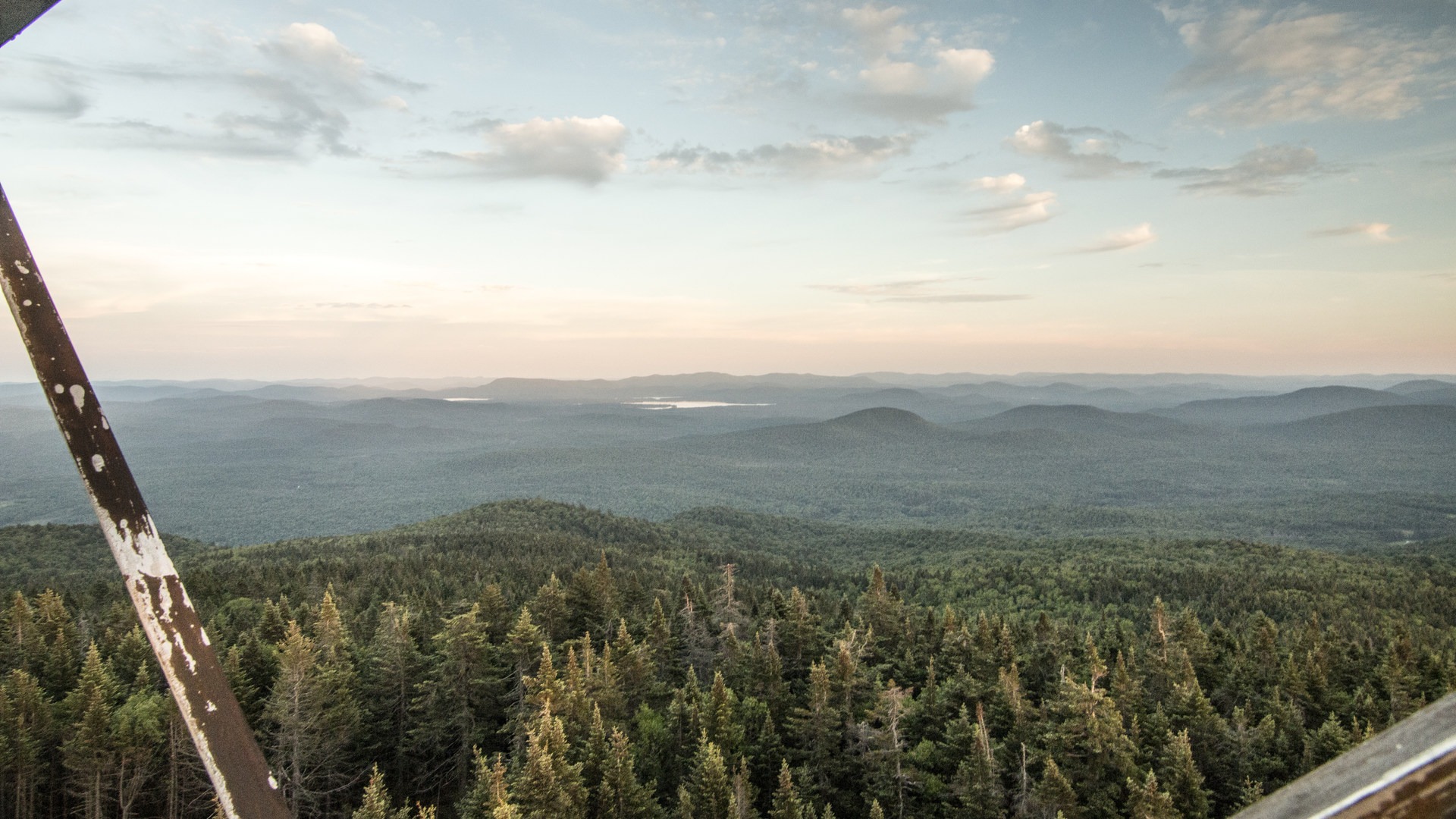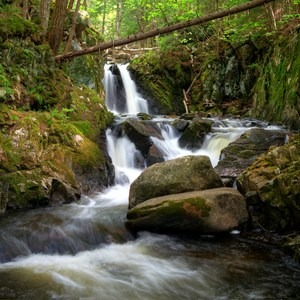You are here
Standing high upon the edge of the West Canada Lake Wilderness, the Pillsbury Mountain Fire Tower overlooks the mixed coniferous forest of the Adirondacks with incredible views that span for miles. The 3.1-mile there-and-back trip to the summit is a challenging, moderately trafficked hike that climbs about 1,500-feet in elevation. There are a few muddy sections to step around, but the trail is well defined with shade that is moderated by deciduous trees that gradually transition to pines. There are no big views along the trail, but once you reach the top, you will be delighted by the perspective this tower has of the surrounding lakes, marshes, and high peaks.
Finding the trailhead takes a decent amount of navigation on dirt roads, but this minor obstacle comes with the benefit of limited public traffic. Heading north on Route 30, there will be a wide dirt road on your left with a sign indicating Pillsbury Mountain. It leads uphill and enters tree cover. This part of the route goes through the Perkins Clearing Easement, and it is sufficiently graded to feel comfortable navigating in a two-wheel drive vehicle. Continue on this route for several miles until you come to an intersection with an information kiosk and a few road signs. Follow the sign to Pillsbury Mountain by taking a left on Old Military Road.
There will be several dirt roads leading off from the main route that may confuse you, but the correct road is the one that is seemingly most traveled and worn. You will reach a clearing that currently has many large piles of stone and dirt. This is called sled harbor, and it is where you should park if you don’t have a four-wheel drive vehicle. Note that the trailhead is about 1.2 miles from this point, so if you cannot drive there, include this additional distance in your time estimate. Continuing up the road there is a very obvious sign to the Pillsbury Trailhead indicating a right turn that leads under thicker tree cover (and is not accessible by vehicles in the winter months). By now your vehicle has earned a new coating of dirt, and the trailhead is only a little farther up this very bumpy road. Finally you will come to a cleared parking area with a registration box. Welcome to the Jessup River Wild Forest. Sign in and begin your hike on the trail to the left following the sign for Pillsbury Mountain.
The hike begins with a short descent down to a narrow stream and bridge crossing. Depending on the season, the bugs may become slightly more noticeable here, but they will most likely disappear as you make your way up the mountain. Continue on a gradual climb for about a quarter of a mile. The narrow path has become compacted with leaves from regular use, and it is lined with small saplings poking their way inward toward the light. The red trail markers serve as guideposts as the trail climbs over small boulders and water runoff paths. There are some places that may be wet and muddy, but they are typically covered with leaves and pine needles.
As you get closer to the top, you will be greeted by the aroma of pine trees. There may be a few fallen trees to duck under, and in one section near the top, high winds have downed a section of trees that you will need to navigate through until they are cleared. You will see a rangers' cabin appear through the trees. This is the top of Pillsbury Mountain, with its large clearing and the prominent 60-foot high steel Aeromotor LS40 tower standing before you.
The cabin was undergoing renovations and construction at the time of this writing. One of the highlights of this hike is the view from atop the fire tower and the climb up the steps. The tower stairs could use some additional fencing, and these unprotected openings may make some people a bit uncomfortable in high winds, but there shouldn’t be any need to worry as long as you keep one hand to the stairs. As you approach the final steps you will be greeted by 360-degree views encompassing the Canada Lake Wilderness, Sacandaga and Indian Lakes, Siamese Ponds Wilderness, Wilcox Lake Wild Forest, Snowy Mountain with its fire tower, and many notable mountain peaks. The lookout is not open, but that doesn't detract from the spectacular sights that can be enjoyed from its deck. In conjunction with cabin reservations, the New York State Department of Environmental Conservation (DEC) plans to refurbish the fire tower and reopen the lookout to the public. At 3,597 feet, this is one of the highest peaks in the Southwest Adirondacks.
History
The first tower at this location was constructed from wood by the Champlain Realty Company in 1918. As part of the agreement, the landowner staffed an observer during periods of dry weather. In 1924 the tower was changed to steel by the Conservation Commission. It remained open until 1985, when it was closed to await restoration.
Fire Towers of New York
For almost a century, observers staffed more than 100 fire towers throughout New York State located primarily on the highest peaks in the Catskill and Adirondack regions. This was in response to the intense logging and tannin harvesting operations that would leave virgin forest barren, dried, and very susceptible to fire. Rangers would often reside in nearby cabins while keeping a regular lookout for smoke and flames throughout the surrounding valleys. If a fire was spotted, a message was sent to the nearby town, and the location of the suspected fire would be triangulated and confirmed by other fire towers in the area.
Beginning in the 1980s the towers were systematically closed as monitoring from planes became more cost effective. Some towers have been dismantled, others remain in disrepair, while a select few have been revitalized by the DEC or purchased and renovated by the general public. Restorations continue throughout the state, and there are many assistance programs you can join to help support and maintain these historic icons. Each tower offers a new and unique perspective of New York and serves as a monument to forest protection throughout the state. Challenge yourself to visit them all!








Comments
Sign In and share them.